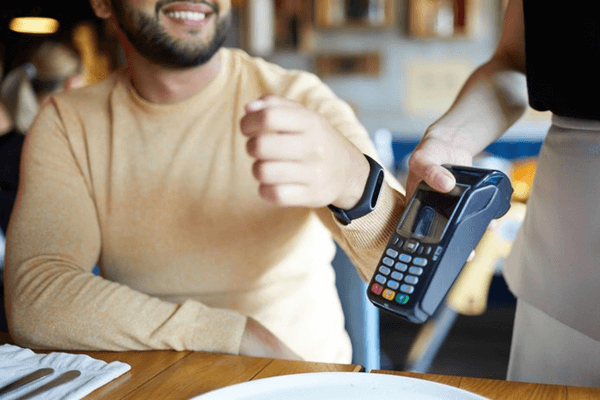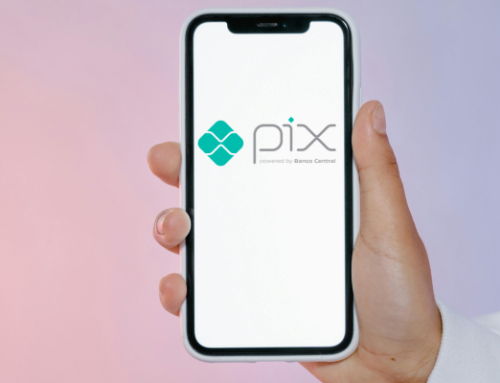
NFC technology is closer to us than we realise.
Do contactless payments using cards, smartphones or smartwatches, opening doors with cards or certifying credentials are some of the most common uses of this technology, but do you know what NFC is and why it is so important in the new means of payment?
NFC: what is it?
Near Field Communication are the words behind this acronym which, in practice, gives shape to a technology that allows two wireless devices separated by a short distance to automatically communicate with each other simply by bringing them closer together.
This communication may seem like something out of a magical universe, but it's not. It all has to do with radio frequency which, from the 13.56 MHz band, with data transmission rates varying between 106, 212 and 424 Kb/s (kilobits per second), allows data to be exchanged.
NFC data transmission can take place in two ways: active or passive.
NFC data transmission active
In the case of active transmission, both devices generate a radio frequency signal, as in the case of a contactless payment between a smartphone and a POS.
Passive NFC data transmission
In the case of passive transmission, only one of the devices generates the radio frequency signal, as in a payment between a TPA and a contactless card (passive element).
In addition to credit/debit cards, smartphones and payment terminals with contactless technologydevices such as smartwatches, smart bracelets, tablets, transport cards or ID cards, as long as an NFC chip can be installed in them, can also be considered "NFC devices".
As for the distance required for these devices to establish a connection and exchange data with each other without any kind of danger of "accidental connection", it is around 10cm at most. For example, in the case of a payment on a TPA by contactless card, it is recommended that the distance between these devices be less than 4cm. Using this example, let's see how an NFC payment works in practice.
How does NFC payment work?
As we touched on in the previous point, one of the most interesting applications of NFC technology is in payments, especially in contactless payments.
Whether through a digital wallet such as Google Pay, Apple Pay or MB WAY, or via a contactless card, it is now possible to pay for a good or service if the retailer/public service side provides a contactless automatic payment terminal.
The process is very simple, fast and secure.
In the case of a customer with a digital wallet installed on their smartphone who wants to pay bills with it, all they have to do is add a credit/debit card to the application and bring their smartphone close to the vendor's terminal.
A few seconds after approaching, the transaction will be finalised and the customer will receive all the data relating to the operation they have just carried out on their smartphone. All this without having to provide any data to the seller, since the digital wallet will intermediate the payment.
The process is similar to a contactless credit/debit card. After the seller enters the payment amount in the Physical TPA (also contactless, remember), the customer just has to bring their card close to the terminal and in a few seconds the transaction is complete.
It should be noted that, in Portugal, every contactless payment has a maximum limit of 50 euros. In the case of consecutive payments, there is also a limit on what the customer can do without entering the PIN (maximum 150 euros or 5 consecutive contactless transactions).
If the customer reaches the limit of consecutive transactions without entering the PIN, they can only make one transaction again contactless after a payment in which you enter your PIN.
Paying with NFC in Portugal
In Portugal, NFC contactless payments are rapidly gaining ground.
According to REDUNIQ Insights report on the evolution of the transactional panorama in our country in the first half of this year,
"around 3 out of 4 card purchases (74%) were made using contactless technology"
percentage, which means that the weight of APT payments using the contactless already account for 55% of the total turnover of businesses linked to the REDUNIQ system.
Innovative payment terminals using NFC technology
Faced with this unquestionable trend towards payment, which makes the contactless the favourite means of payment for more and more Portuguese consumers, it is essential that businesses adapt their means of payment to these new consumer habits by introducing innovative payment terminals.
This is the case with TPA Android REDUNIQ Smart which, in addition to allowing business to accept contactless payments with card, chip, MB Way, Google Pay and Apple Pay, brings a set of built-in management apps that help businesses and allow them to be totally mobile and digital.
In addition REDUNIQ Easy terminalwithout commissions or loyalty periods, allows you to accept contactless paymentswithout the worry of various fees. For a monthly amount adjusted to the business, they receive a free terminal and can accept payments by national and international credit and debit cards, contactlessMB Way, Google Pay and Apple Pay. Allowing retailers to take advantage of yet another way to increase sales and, consequently, their turnover.


